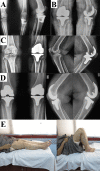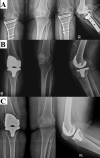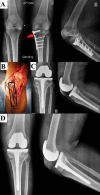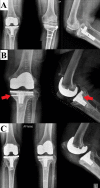Total knee arthroplasty post-high tibial osteotomy, results of an early experience from a North African arthroplasty unit, and a comprehensive review of the literature
- PMID: 37730629
- PMCID: PMC10510125
- DOI: 10.1186/s13018-023-04199-1
Total knee arthroplasty post-high tibial osteotomy, results of an early experience from a North African arthroplasty unit, and a comprehensive review of the literature
Abstract
Purpose: To report an early experience after converting HTO to TKA by reporting the incidence of functional, radiological, and complications in a single surgeon case series from a North African specialized arthroplasty unit.
Methods: Between 2010 and 2020, 33 knees in 31 patients (two bilateral) were operated upon, 24 females and seven males, had a mean age of 65 ± 4.5 years; 17 (51.5%) knees had medial wedge opening (WMO), while 16 (48.5%) had lateral wedge closure (LWC) osteotomies. The mean time from HTO to TKA was 8.1 ± 3.3 years. A posterior stabilized (PS) implant was used in 31 (93.9%), while in 2 (6.1%), a varus-valgus constrained (VVC) implant was used. A tibial stem was needed in 13 (39.4%) knees. The functional assessment was performed according to the Knee Society Scoring System (KSS). The radiographic assessment included the anatomical femorotibial angle (aFTA) for alignment, the medial proximal tibial angle (MPTA), and the tibial slope (TS).
Results: After a mean follow-up of 4.3 ± 1.1 years, the KSS knee and function sub-scores improved from a preoperative mean of 41 ± 8.9 (26 to 57) and 37.7 ± 9.2 (25 to 55) points to 91.3 ± 3.8 (81 to 94) and 85.5 ± 5 (80 to 95) points at the last follow-up, respectively (P < 0.05). The preoperative knee flexion improved from a mean of 84.5° ± 15.9 (55 to 110) to 110.6° ± 9.3 (95 to 125) (P < 0.05). The aFTA improved from a preoperative mean of 182.2° ± 10.3 (164 to 205) to a postoperative mean of 186° ± 2.6 (179 to 190) (P < 0.05). The MPTA changed from a preoperative mean of 88.4° ± 6.7 (77 to 102) to a postoperative (tibial component alignment) mean of 90° ± 1.7 (85 to 94) (P < 0.05). The mean preoperative TS changed from 80.9° ± 7.3 (68 to 96) to a mean postoperative of 86.9° ± 1.3 (83 to 89) (P < 0.05). Non-progressive radiolucent lines were detected at the tibial component in four (12%) knees. Complications were reported in seven (21.2%) knees; no revision was needed in any knee.
Conclusions: The authors' early experience showed improved functional and radiological outcomes; however, the complication incidence was relatively high, but no knees required revision. A longer follow-up is mandatory to prove the consistency of the results.
Keywords: Conversion; High tibial osteotomy; North African; Total knee arthroplasty.
© 2023. BioMed Central Ltd., part of Springer Nature.
Conflict of interest statement
The authors declare that they have no conflict of interest.
Figures





References
Publication types
MeSH terms
LinkOut - more resources
Full Text Sources
Medical

